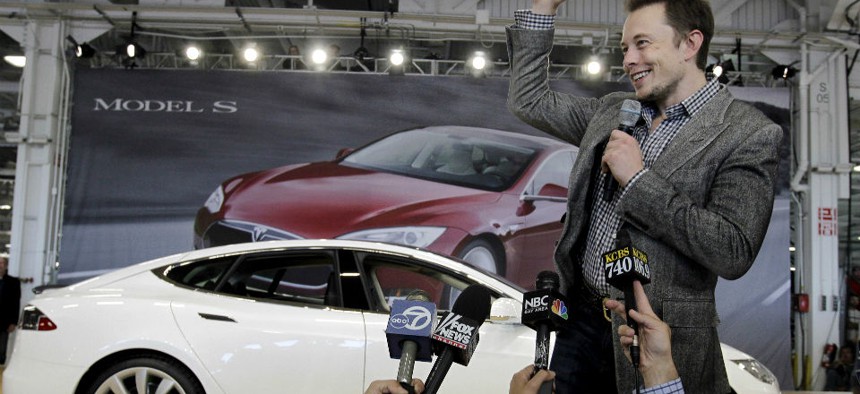Why Tesla Gave Up on Patents

Tesla CEO Elon Musk waves during a rally at the Tesla factory in Fremont, Calif. Paul Sakuma/AP File Photo
Elon Musk's decision is both altruistic and smart business.
Elon Musk surprised many Thursday when he declared in a blog post on Tesla's website that the company planned to renounce enforcing its patents and open up the technology behind the company's trademark electric cars.
Not all of Tesla's patents will be made public, but several hundred will, and “ultimately thousands,” according to Musk, who discussed the new company policy in a conference call with shareholders and the press.
“Yesterday, there was a wall of Tesla patents in the lobby of our Palo Alto headquarters,” Musk wrote in a statement. “That is no longer the case. They have been removed, in the spirit of the open source movement, for the advancement of electric vehicle technology.”
Tesla had a purely materialistic drive in developing patents for its cars, Musk notes, recalling his first venture, Zip2, and how he “thought patents were a good thing and worked hard to obtain them.”
But now, he questions the societal benefit of patents.
“I don’t really like patents, it’s not my favorite thing,” Musk said on the conference call. “I think there is a lot of abuse of the patent system these days. It’s rare to read that some individual inventor [created] technology benefitting [society]. That’s not what you usually read about. I can’t remember the last time I read about something like that.”
This made me wonder: Are there other patent-less inventors who created for the greater good? How rare is Musk’s suggestion that most inventions are for profit?
Rare, but not as rare as Musk implied. A little digging around shows that every so often, inventors willingly turn away from the cash flow guaranteed by a patented product’s demand.
There’s John Walker, who invented the humble match. Walker, a chemist, adamantly refused to patent his creation in the 1820s, believing it to be important for mankind.
Then there's India's "Menstrual Man," Arunachalam Muruganantham, whose wife's inability to afford sanitary napkins inspired him to test a low-cost, hand-operated machine that produces a cheaper alternative to the soiled rag the inventor's wife was using. "I could have sold this machine for a few million [rupees] and earned money," Muruganantham has said of his plan not to pursue a commercial patent. "But I thought the sanitary towel machine I invented can help poor families have a livelihood. So I decided to give it to women as poor as my mother."
Perhaps the most famous patent-shunning inventor of all time? Sir Tim Berners-Lee, the creator of the World Wide Web, didn’t want a penny for the Internet he built at CERN. Not doing so, argue many, made for a more open, democratic web presence that would have fundamentally been impossible without Berners-Lee's insistence that the web be free for all.
The example of Berners-Lee hints at why Musk would open his company's secret technology to the world.
Musk faces a catch-22 similar to what Berners-Lee faced in the early days of the Internet: For the web to become the invaluable resource that it is today, it needed mass usership. Similarly, electric vehicles are hampered today because there aren't a critical mass of users, meaning states and businesses have little incentive to develop the infrastructure (i.e. widespread electric-vehicle charging stations) that EVs require.
Musk recognizes that patents hold back competition, which in turn slow down innovation, to society's detriment. "Our true competition is not the small trickle of non-Tesla electric cars being produced, but rather the enormous flood of gasoline cars pouring out of the world’s factories every day," he said.
But of course more electric vehicles doesn't just mean fewer gasoline cars. It also, in the long run, means more charging stations which, hopefully in turn means more electric vehicles.
So is Musk's decision for Tesla's benefit or for society's? Both. Musk knows a little healthy competition means less polluted air, stalling the grim effects of global warming, and healthier lifestyles. If it takes getting rid of patents, so be it.
NEXT STORY: This Is What the ATM of the Future Looks Like





